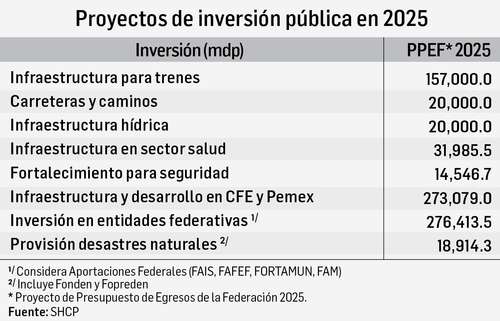Spending on social protection per capita will have grown 50.9 percent in 2025 compared to 2019, going from 11,139 pesos to a record figure of 16,813 pesos, reported Rogelio Ramírez de la O, head of the Ministry of Finance and Public Credit. (SHCP) by participating in the morning conference of President Claudia Sheinbaum.
In 2023, social spending per inhabitant was 14,443 pesos and will reach 16,256 pesos at the end of 2024.
The government’s priority social programs, the official detailed, will total 835,700 million pesos, according to the 2025 Federation Expenditure Budget, of which 483,400 million pesos correspond to the pension for older adults.
Ramirez de la O has stated that the resources dispersed to the population through priority social programs have contributed to greater consumption, which together with the physical investment of 996 billion pesos, considered in the economic package for 2025, allow the government estimate next year’s economic growth between 2 and 3 percent.
The economy continues to maintain growth, from January to July (2024) investment is growing 8 percent and consumption 3.3 percent (…) There is no reduction in the total amount of investment. It is a historical figure of 996 billion pesos in investment
he assured.
The total investment is 996 billion pesos – which includes financial investment – we are talking about physical investment projects that total 811 billion pesos which by 2025 are divided into: 157 billion pesos in infrastructure for trains, 20 billion in highways and roads, 20 billion in water infrastructure and 31,986 million in health sector infrastructure.
In security strengthening, 14,547 million; in infrastructure and development for the Federal Electricity Commission (CFE) and Petróleos Mexicanos (Pemex), 273 billion, and the investment to be exercised by federal entities is 276 billion. The provision for natural disasters totals 18,914 million, detailed the person responsible for the country’s public finances.
The budget covers all the needs we have in the public and social sectors, as well as in infrastructure, and is also guaranteeing the payment of debt service and the payment of contributions and participations to federal entities.
He explained that in both consumption and investment there was a downturn in a couple of months in 2024 because there was a drought, but that this and other events are being reversed.
On the other hand, Ramírez de la O was questioned about the adjustments that the price of oil would have, which for 2025 is estimated at 58.4 dollars per barrel.
The price of oil can rise if there is something in Ukraine and can collapse if President Trump goes ahead with his project to increase production to the maximum.
He indicated that to project the price of a barrel of oil, the Treasury uses a formula developed in the 1990s.
It is a formula that takes into account futures, the averages of the last 10 years, it is a formula that mixes several things, it is not in the law
he stressed.
He argued that Mexico is shielded in many angles, “and that the tail risks, that is, the extremes of the probability curve, are risks that the Treasury cannot use for the budget.

Visitor message from loraineakers – The Who Community Board
Estudioromanelli on Doodle or Die
albinarichardson albinarichardson’s Biography | Muck Rack
Gcslot: Panduan Lengkap Daftar Dan Login Slot88 – michellesellslv
Grups – Rezero
Certificate verification problem detected
Editor “ardensgardenjuice” – MusicBrainz
Apakah Iliilifarms Platform Game Online yang Anda Cari?
Certificate verification problem detected
Certificate verification problem detected
tressieallen | Read the Docs
Profile of matildarobinson
Profile → Mis cursos – E-Global
Hit77: Platform Tepercaya Anda untuk Perjudian Daring – Surga33
Коментарі читачів
symbiota.mpm.edu/profile/userprofile.php?userid=30163
carme laguy · GitLab
devonchambers – Pixabay
Mengapa Koneksi Stabil Penting bagi Pemain Tangkasnet
PQRD –
Certificate verification problem detected
Profile – amadowilliam – Melanoma Research Foundation
Article Ment | Article Ment
Hit77: Terjun ke Dunia Permainan Slot yang Menyenangkan – tata4d
Panduan Rtp Live Slot Online: Strategi Untuk Maksimalkan Kemenangan | anabelnicholasのブログ – 楽天ブログ
Mahjong Ways: Kemenangan Mudah di Situs Pendaftaran Slot Teratas
elmaholden | elmaholden – Roberts Space Industries | Follow the development of Star Citizen and Squadron 42
antonesavage Garrett's (esperanzafritzvedavoss) software portfolio | Devpost
Tipga – Colocadores
Arden's Garden Juice Bar & Smoothies Monroe – – Digital Marketing Platform